Solar panels for the home – A guide to everything you need to know
Are solar panels worth the hype? From how they work to costs and installation, we break it down
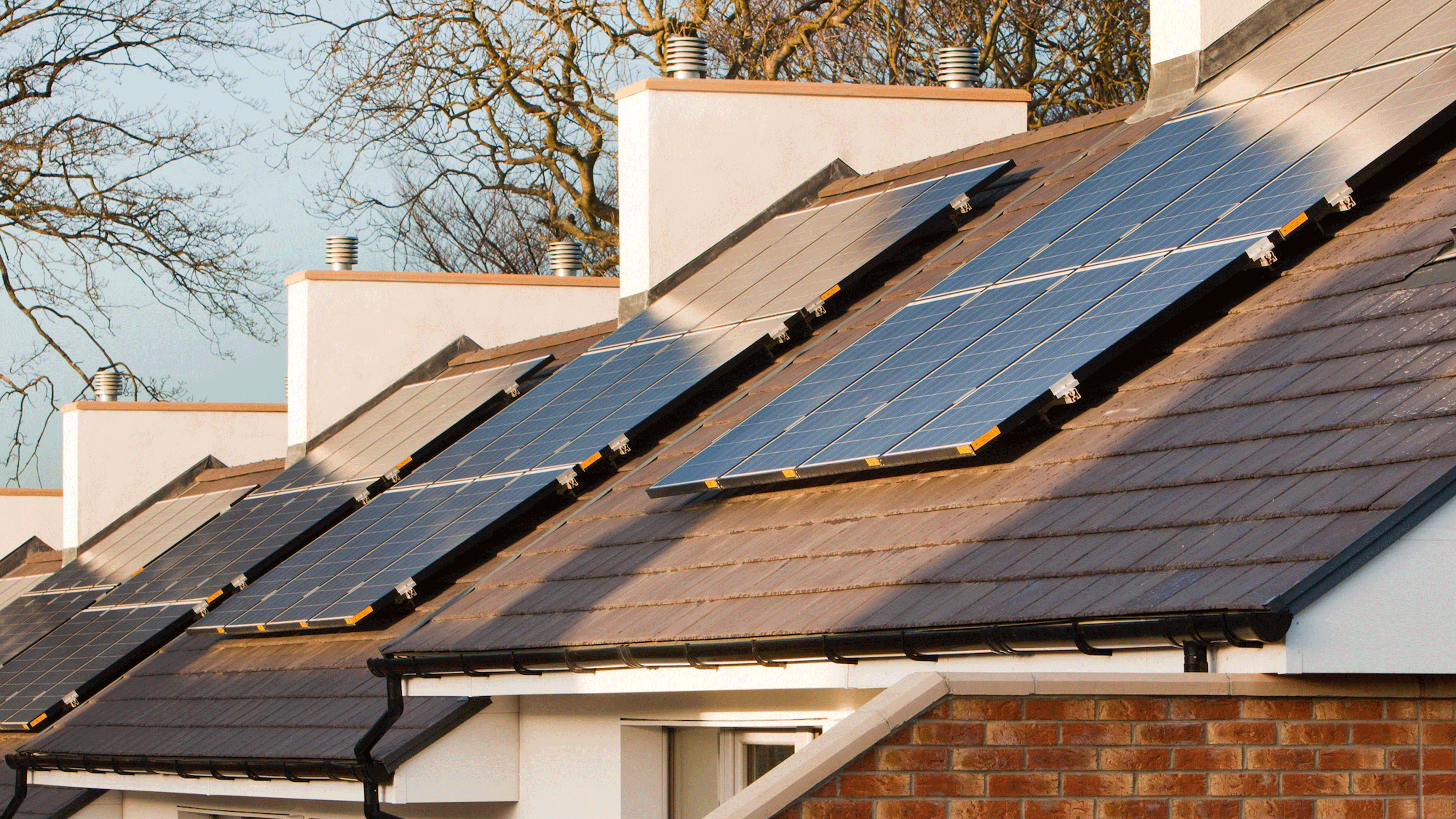

Katie Sims
If you're wanting to reduce your home's carbon footprint and reduce your energy bills over time, solar panels are a strong contender. But there's a lot to learn before you make the switch to solar energy, and it's important to get clued up before you invest.
A rising cost of living plus the increasingly alarming news about climate change means that many of us are looking at ways to save energy at home. And it seems that more homeowners are relishing the dual benefit of solar panels, as a means to cut their bills down and release fewer emissions into the planet.
But solar panels come with a hefty price tag, plus the need for a professional instalment. There's a chance you might need planning permission to install solar panels too. Different types of solar panels which have different effects, so if you're considering making the investment, it's essential that you do your research and learn which type is right for your home.
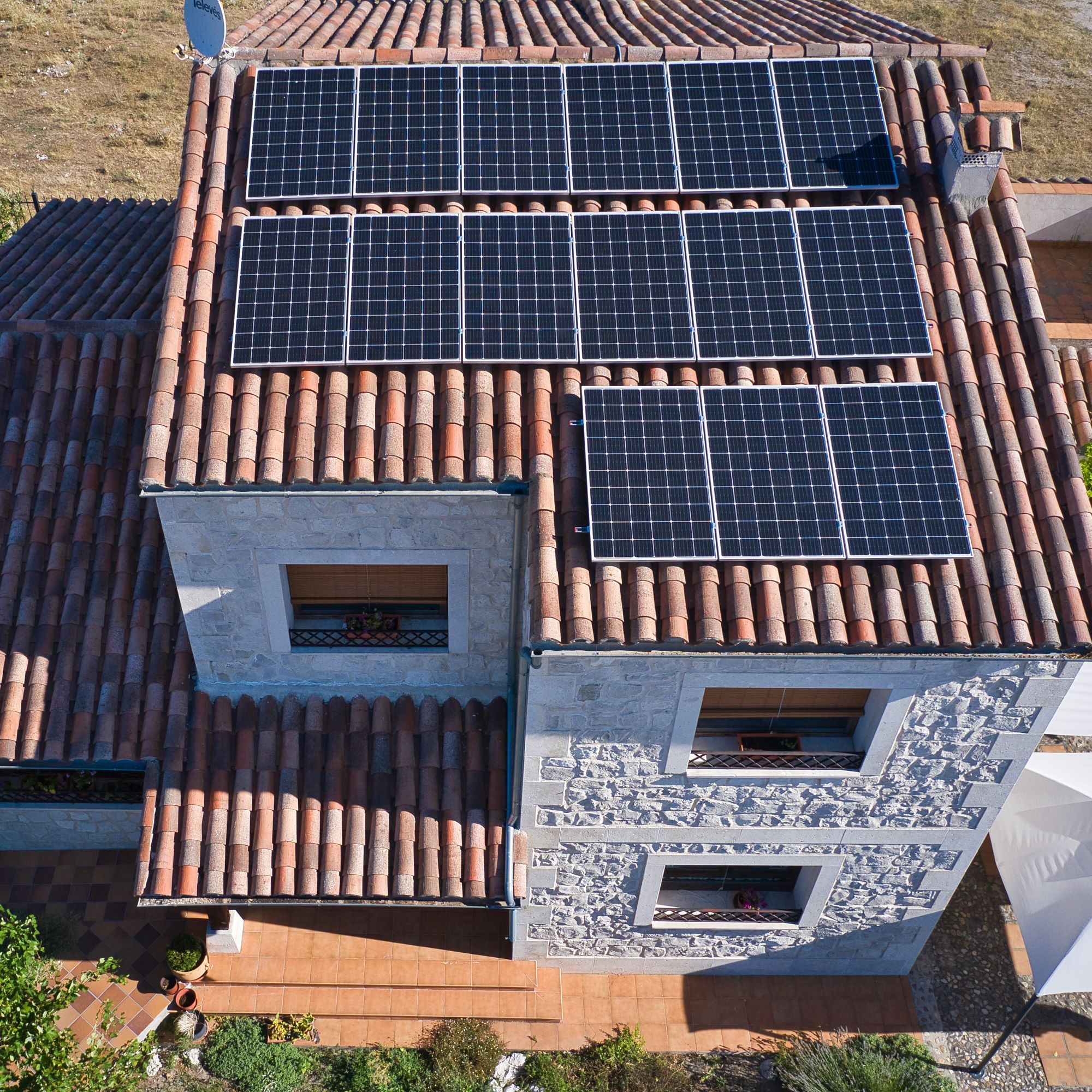
Solar panels - everything you need to know
There are currently around 1.2 million homes with solar panels in the UK, according to the latest MCS installations data. And the numbers aren't showing signs of stopping. So, why are so many people switching to solar energy, and should you be doing it too? In this guide we break down everything you need to know about solar panels, so that you can decide whether or not to join the hype.
Packed full of up to date information and advice from the experts, this is your essential guide to solar panels. We'll cover the types of solar energy, the installation process, plus costs and what grants are available.
What types of solar panels are available?
There are two main types of solar panels: solar thermal for your hot water, and photovoltaics, also known as solar PV, for your electrics.
There are, naturally, differences between the two. So it pays to know what will suit you and help with how to keep your home warm.
Sign up to our newsletter for style inspiration, real homes, project and garden advice and shopping know-how
1. Photovoltaic panels

PV panels are made of a polycrystalline material containing silicon cells and strips of wiring, known as ‘buzz bars’, framed in metal and cased in glass. They convert light into energy while the sun is shining. So it’s a good idea to get your washing done, run the dishwasher and carry out any other high-powered tasks then, which is one of the solar power disadvantages - at least when using this type.
These are best placed on a south-facing roof so they absorb as much light as possible during the day.
How do PV panels work?
'Solar PV panels convert the sun’s energy into electricity. They contain solar cells which produce direct current energy when exposed to sunlight,' explains Jina Kwon, UK and Ireland GM, Otovo. 'This electricity must be converted to alternating current to power domestic appliances. Once solar electricity has passed through an inverter it can power electrical items around your home.'
'The cells in the panels have been dyed the right colour to ensure that the correct spectrum of light is enabled and reacts accordingly when the light hits them,' expands Ben Robinson, Director, Exeo Energy.
'This creates electrons that pass between the two sides of the cell generating the current. This is fed along the buzz bars and into an inverter box that converts it into power. You then connect all your solar panels together, so you get a large-scale version that increases the voltage.'
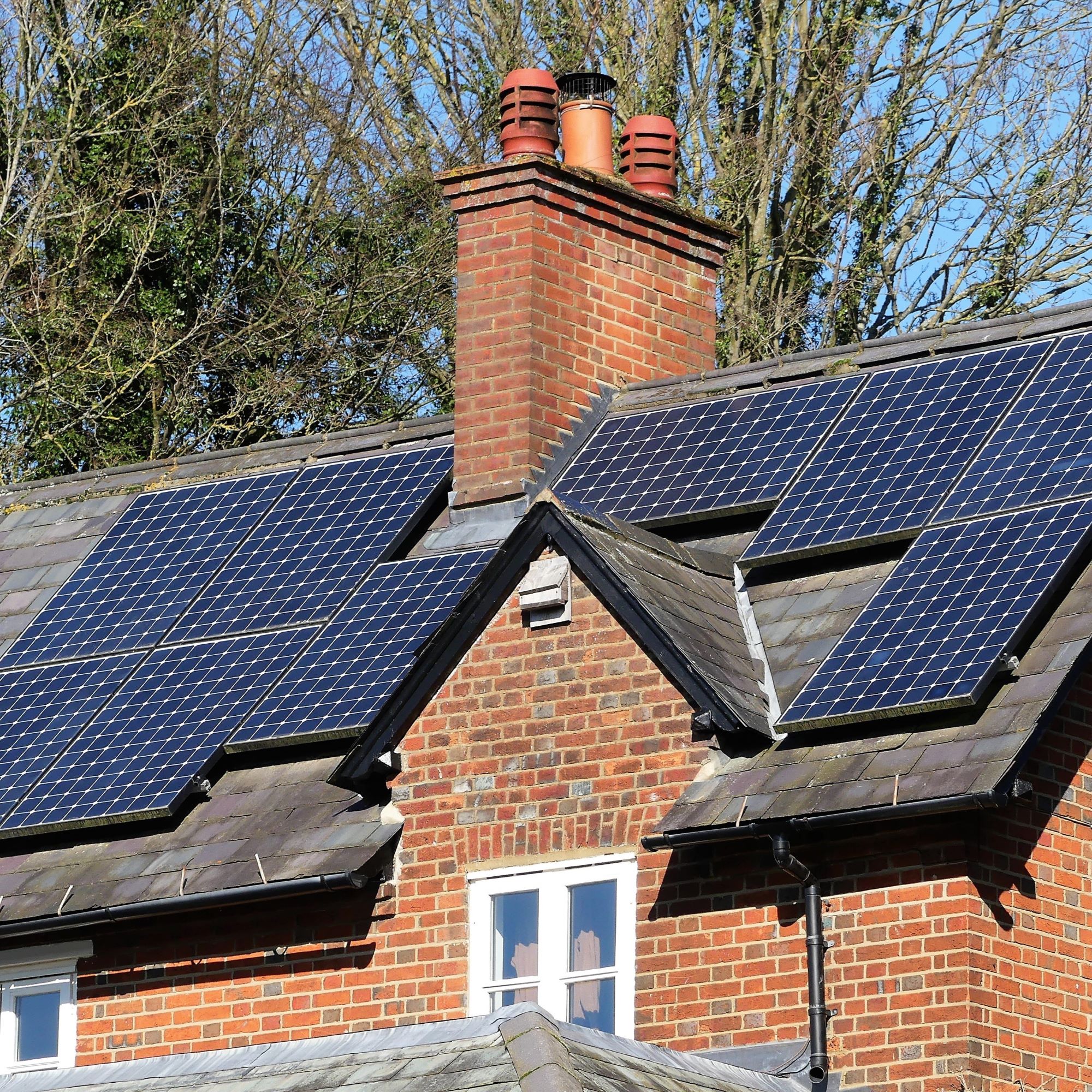
At night, or in winter, where the sun isn’t strong enough to generate solar power, your home will automatically revert to using electricity from the national grid. Likewise, any solar energy not used during the day will also be fed back to the grid, which you will be paid for via the Smart Export Guarantee scheme (more on this below).
If you’d prefer to keep your solar energy for your own use, rather than send it back to the grid, there are battery systems available that keep it stored for when the sun isn’t strong enough for generation. 'The electricity gained from this should power the average house for one or even two days,' adds Tony Sampson, Managing Director, Naked Solar.
While there are various technologies that give PV panels different aesthetics, all-black panels see the highest demand for residential homes as these tend to blend with roofs best. Even better, you can now get sunken panels that lie flush with the roof, which are even more unobtrusive. 'If you’re working on, or replacing, your roof, this is a good time to install these,' says Ben.
2. Solar thermal panels
The key difference between solar thermal and photovoltaic panels is that solar thermal works on UV rays, rather than sunlight itself. This means they still work effectively in diffused, or lower levels, of sunlight.
'This means that even on a light cloudy day, you’ll still generate a decent amount of energy from your panels,' says Richard Blackmore, renewable technical support at Gregor Heating.
How do solar thermal panels work?
'Solar thermal panels take in the energy from the sun to produce heated water stored in a hot water cylinder,' says Jina at Otovo. 'You must have a water storage cylinder already installed or have the space in your home to have one installed to make this system work.'
The thermal panel setup for most domestic houses will consist of two panels on the roof, with a pair of pipes that run to a solar pumping system in the roof, and another pair running down to the hot water cylinder.
According to Richard from Gregor Heating, this setup should provide the bulk of your hot water from March through to September and October. 'During the winter the system will then act as a pre-heater, taking your water temperature up to about 30/35 degrees, until your boiler tops it up to the required temperature,' he says.
The setup is completely separate from your existing hot water system, but it does work in conjunction with it. So, if you’re looking to upgrade your current property, rather than starting from scratch on a new build, you’ll need to change your cylinder from a standard to a twin coil model to accommodate the new hot water source.
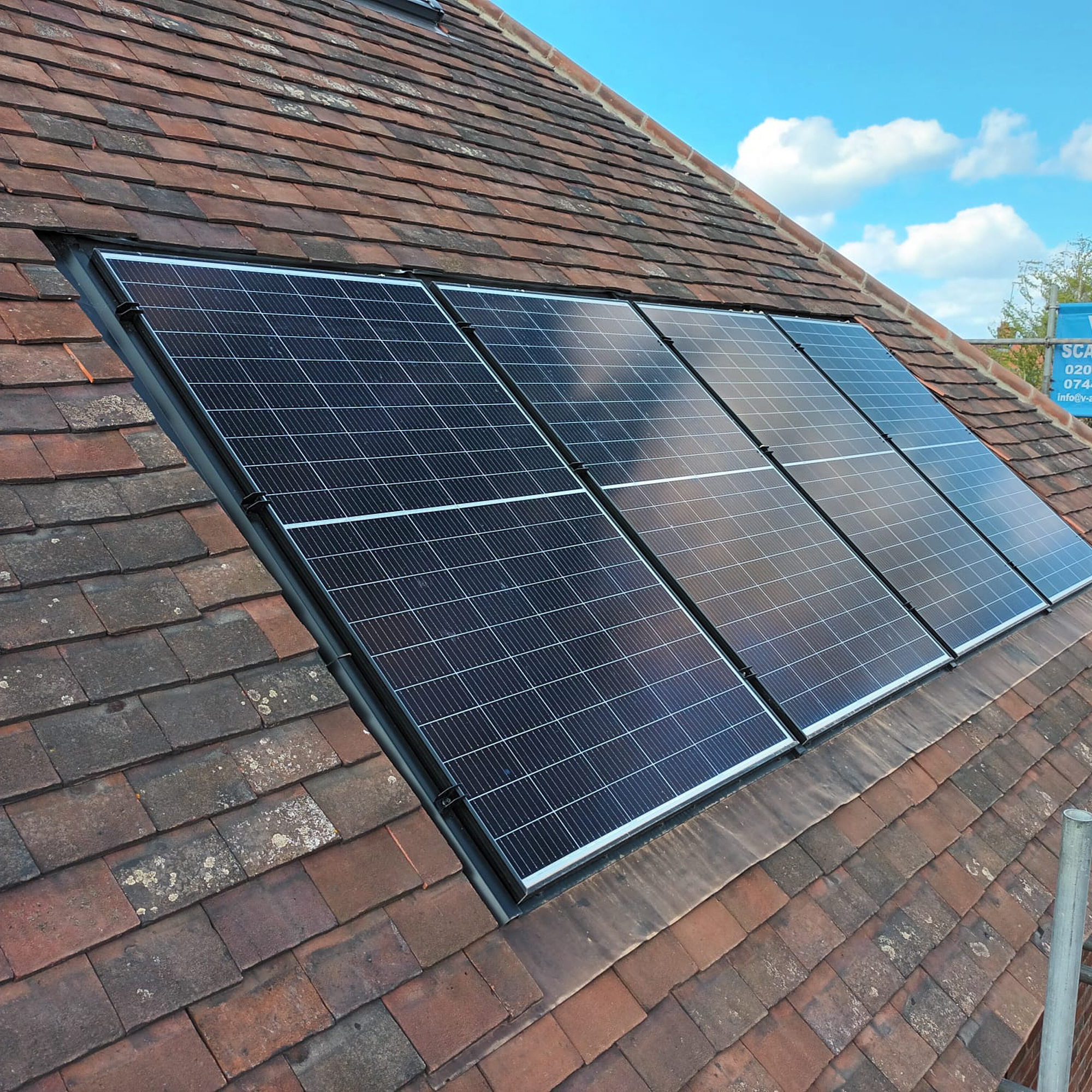
As a bonus, most solar thermal systems only use two 2m x 1m panels, in comparison to the run of 10 to 12 that is needed for photovoltaics. Like with solar PV, they can be roof-mounted or there are in-roof options, too.
'Solar PV generally takes more space on a roof whereas solar thermal takes up more space within the house,' Jina summarises. 'But solar PV offers more flexibility as the systems generate electricity, and with that electricity you may heat your hot water as well.'
How are solar panels installed?
The installation process of solar panels differs depending on the types of panels being added. 'It’s important to search for and find qualified technicians to install solar panels, so look for installers that are accredited,' says Nathan Hyatt-Mitchell, Heating Engineer, Rated People. 'Make sure you get at least three quotations if you can from accredited installers as it’s always best to shop around and not go with the first company that offers you the cheapest price.'
Photovoltaic panels

According to Jina, 'solar PV system installation is straightforward with an average system typically taking 1-2 days installation.'
- Firstly, you'll need a consultation with a certified and reputable solar PV installer. 'Installers can guide you on choosing a system that is right for you, based on your actual electricity consumption patterns and expected changes to consumption to make sure your system is not oversized and thus overpriced,' says Jina. They will assess the roof type, structure and covering to determine the correct products and number of panels needed.
- Next, it’s time to install the scaffolding and make sure that the roof is safe to work on.
- Then it’s time for installers to put up the framing and solar panels.
- Finally, electricians will connect up the panels and install the inverter, meter and switch gear and plug it into the home’s fuse board. That's it! Your PV panels will be ready to start generating your home's electricity.
Solar thermal panels
'Solar thermal panel installations require an MCS accredited surveyor to inspect your property', says Jina. 'Thermal panel installations are mostly plumbing systems with a small amount of electrical wiring, roof installation, and system assembly.'
- The roof will firstly be surveyed to determine the correct products to use for your home’s covering.
- The only incision made in the roof is in the felting for the pipes that run to the solar pumping station. This is then carefully covered over to prevent water ingress.
- Then it’s time to hook the panels onto the brackets. Solar thermal panels are a lot heavier than solar PV. Depending on the results of the initial assessment, you may need a structural survey carried out to ensure the roof can handle the weight of the panels.
- Evacuated tubes are added at the last moment as they begin to generate heat immediately which can damage the system if transfer fluid is not in and up to pressure.
- Then it’s time to mount the solar pumping station in the loft. It's important that the correct pipes due to the heat of the water generated from the solar – sometimes it can reach over 100 degrees.
- You will need to install a new dual coil water cylinder as well as the pump and system control panel. This may require additional plumbing. You will also need to install a new thermal store/hot water tank to store the heat from the solar thermal collector.
As you can see, the installation process for solar thermal panels is a little more complex than PV. Experts don't recommend that you install solar thermal panels yourself, as it's more likely that a professional can see the process through correctly.
How much do solar panels cost?

When it comes to how much solar panels cost for the average British home, budget £6,000 to 7,000 for the installation of Photovoltaic panels. The good news is that this is much lower than what it used to be, with an average budget of £15,000 required back in 2010.
'The price of solar panels themselves has come down dramatically,' says Ben from Exeo Energy. 'A large proportion of the cost of an installation is often tied up in the scaffolding.'
'You need edge to edge protection for your roof so it can be quite a chunk of the overall budget. That means that, if you need to carry out any other roof work, or to paint the front of your property, it can be much more cost-effective to install your solar panels at the same time.'
Solar thermal panels cost slightly less. 'You should look to budget around £5,500 for a typical two-panel solar thermal system, plus VAT,' advises Richard. 'The VAT element is only five per cent, though, as long as there’s no additional panels, so that’s positive.'
Unlike solar PV, where there are no grants available, owners of solar thermal panels can benefit from recouped costs via the Renewable Heat Incentive, see below.
Get a quote to install solar panels on your home from The Eco Experts
Fill out the form to get a free quote for solar energy solutions for your home. Whether you want to cut your carbon footprint, save money on your bills – or both – The Eco Experts can help you find the right products for your home.

What solar panel grants are currently available in the UK?

Though there are still some grants for solar panels available, there's definitely less than what there used to be, mainly because solar panels are a lot cheaper to buy and install nowadays.
The current government grant in operation is ECO4, which is an energy efficient scheme supporting low-income and vulnerable households. Under ECO4, participating energy companies offer funding to eligible applicants for renewable energy sources, like solar panels.
To be eligible, you must be in receipt of some form of government benefits, plus own your own home or have permission from your landlord before you apply. You may also be eligible if your home has an energy efficiency rating of E or lower, or if you receive the Warm Home Discount.
There's also the Smart Export Guarantee initiative, which isn't really a grant, but it can help you earn some money back from the electricity generated by your solar panels.
'If you’ve installed solar panels on your property, then the Smart Export Guarantee (SEG) scheme is a government financial initiative which enables small generators to export their electricity back to licensed SEG energy providers for the National Grid,' explains Chris Delaney, Managing Director, GreenBuildingRenewables. 'SEG licensees set their energy tariffs themselves, so you must shop around to find the most competitive rate.'
FAQs
How many solar panels are needed to power a typical house?
'On average, a standard one-bedroom house uses 6 panels. If you have a 3-bed home, it will need 10 panels. For 5 bedrooms, you’ll need 14 panels for it to be worthwhile', says Nathan from Rated People.
Keep in mind that these guidelines are generalised, and the number of bedrooms doesn't have an exact conversion to the number of panels needed. There are a number of factors that will influence how many panels are needed to generate power for your home.
'Every PV solar installation will vary depending on the size of the site for the panels, building orientation and energy requirement, so how many panels a homeowner might need can only be estimated once individual specifications have been evaluated,' says David Lukeman, CEO, Heat Electric.
The biggest factor that will determine the number of panels needed is the energy usage in the house. Your supplier will be able to discuss in detail how many panels your home needs exactly.
What are the two main disadvantages of solar energy?
Though solar panels are great for many reasons, there are a couple of drawbacks to consider. If you have PV panels, they work better on some days than others, as they require the sun's light to generate electricity.
'Given the dependence on sunlight, maximum production occurs when the sun’s light is longest in a day, between March and October,' says Jina from Otovo. 'That being said, solar panels work year-round and panels work efficiently in the winter months. Regardless of the fact there are fewer hours of sunshine on a winter’s day than in the summer, your energy supply will continue unimpeded.'
'There have been disadvantages in the past with solar energy. Mainly they have been used to boost existing systems with free energy when the sun shone,' says David from Heat Electric. 'Now storage of solar-generated power is much more sophisticated and offers consistency and longevity, making the best systems the smart decision for people looking to save money and contribute to climate-positive living.'
So though the requirement of sunlight can be seen as a disadvantage, it's not something you would feel the impact of in reality. The other main drawback to consider is the length of time it takes to start making money back because of the upfront cost. Despite solar panels decreasing in price over the last decade, it can still take 5 years+ to start seeing a return on investment.
'After around 5-10 years, your total savings outweigh what you paid for the system, meaning thereafter all of your solar-generated power is free,' says Jina. 'You also secure that portion of your electricity for a very long time, 20-30 years meaning you can worry less about electricity price increases of which on average since 1981 have been 6.4% yearly.'
Of course, do your research to make sure you fully understand the disadvantages of solar panels before you take the plunge and invest.
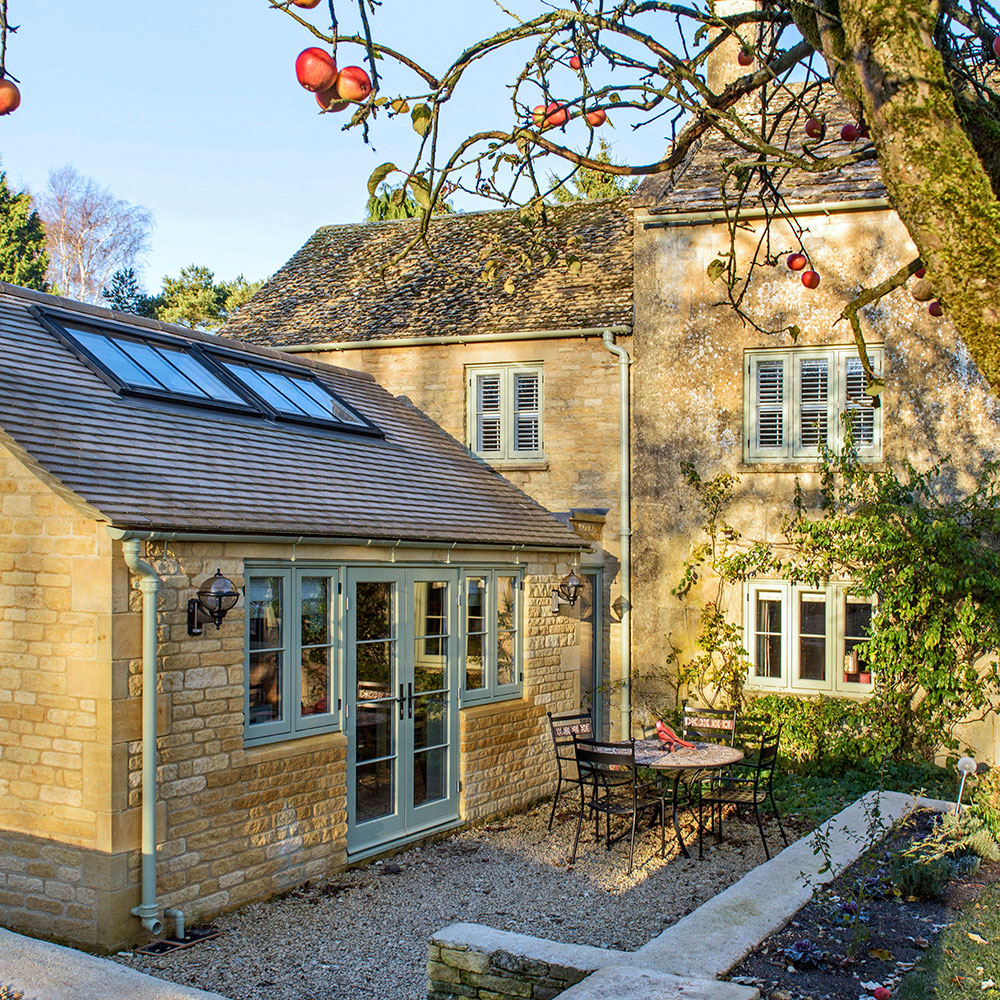
Are solar panels worth it?
Essentially, yes, solar panels are worth it. Both kinds of solar panel can help you make savings on your energy bills, while helping to chip away at the UK’s reliance on fossil fuels.
'If you’ve got a large family, lots of bathrooms, and water usage is high, a solar thermal system is absolutely worthwhile. You might not use your boiler and, thus, any gas or oil, at all during the summer months,' says Richard from Gregor Heating. 'But if you’re in a one-bed flat where it’s not easy to install or there’s no roof access or you only have a very small tank, then it’s probably not for you. This system is aimed at properties where installation is easy.'
Really, it’s up to you to decide whether the savings you can make on your bills are worth the cost of installation. Plus, make sure you're aware of upkeep, such as how to clean solar panels. But Tony reiterates that demand for solar PV is growing. He adds that some customers have even wanted installs before moving. They believe the panels will increase the value of their home.
'There are clearly a lot of people that think solar panels are worth it,' Tony says. 'We can’t keep up with demand. Plus, new battery technology means it’s a lot less critical to use the energy your panels create during the day, as was the case in the past. Now it can be stored until you need it, which is much more efficient.'

Amy Cutmore is an experienced interiors editor and writer, who has worked on titles including Ideal Home, Homes & Gardens, LivingEtc, Real Homes, GardeningEtc, Top Ten Reviews and Country Life. And she's a winner of the PPA's Digital Content Leader of the Year. A homes journalist for two decades, she has a strong background in technology and appliances, and has a small portfolio of rental properties, so can offer advice to renters and rentees, alike.
- Katie SimsContributor
